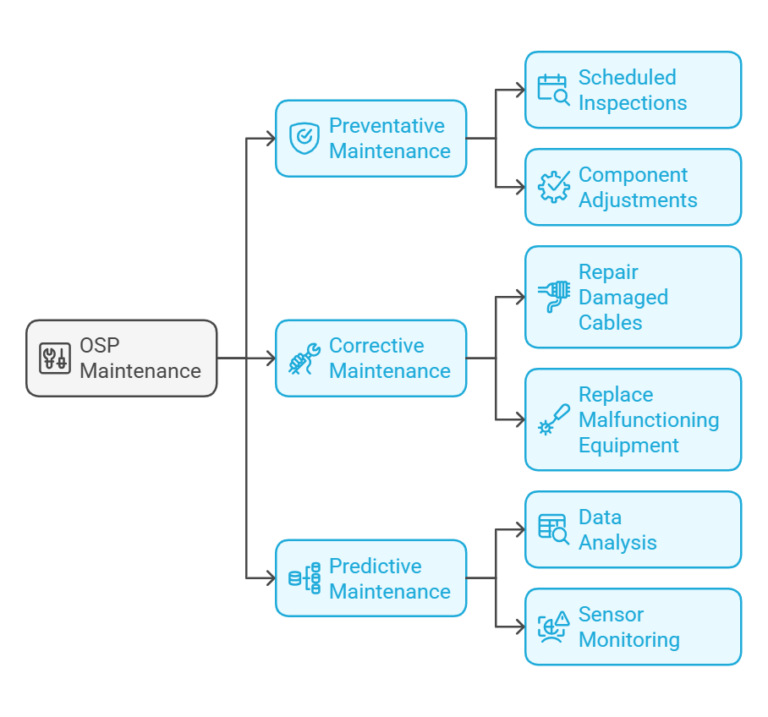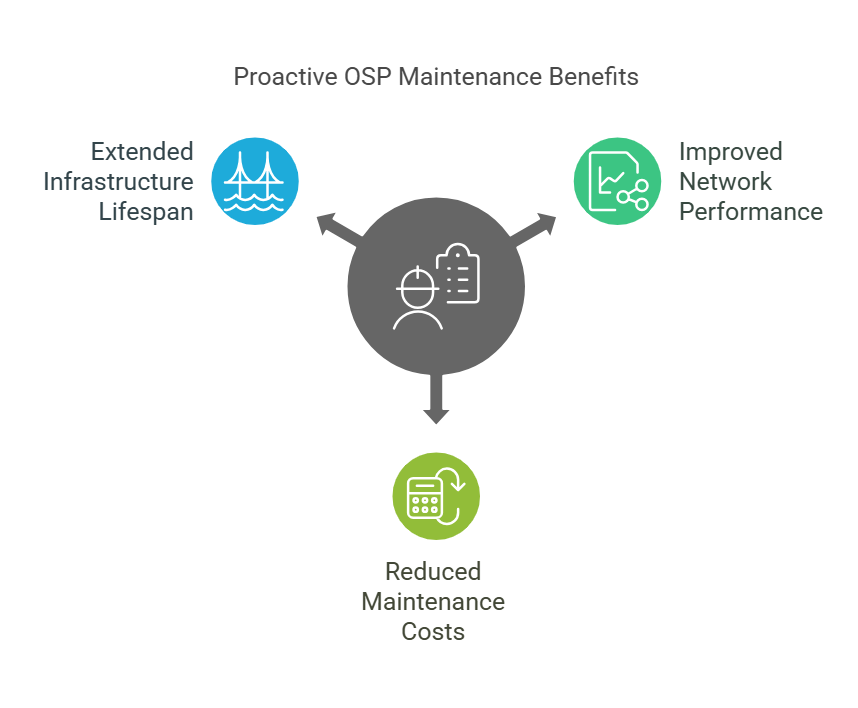OSP Maintenance Strategies for Long-Term Network Performance
Effective OSP (Outside Plant) maintenance is essential to ensuring the reliability, performance, and longevity of your network. Whether you’re managing a fiber optic network or a larger telecommunications infrastructure, regular maintenance practices can help prevent costly repairs and unexpected downtime. At DataField Technology Services, we specialize in providing comprehensive OSP maintenance strategies that optimize network performance, extend the life of your infrastructure, and mitigate potential issues before they arise.
The Importance of OSP Network Maintenance
Ensuring Longevity and Performance of Your OSP Infrastructure
Maintaining your OSP (Outside Plant) infrastructure is crucial for ensuring its longevity and optimal performance. Regular maintenance practices prevent network degradation and address potential issues before they compromise the system.
By staying proactive, you can extend the lifespan of critical components like fiber optic cables, poles, ducts, and other infrastructure elements. This proactive approach ultimately results in fewer disruptions, increased network reliability, and a lower likelihood of expensive repairs, helping your system serve its intended purpose efficiently for years to come.
Why Routine Maintenance is Critical for OSP Systems
Routine maintenance is the cornerstone of an effective OSP network management strategy. OSP systems are exposed to harsh environmental conditions, wear and tear, and occasional external damage. By conducting regular checks and scheduled inspections, you can identify issues before they escalate into costly failures.
This not only improves the overall network’s performance but also prevents extended downtime, which could affect service quality. Regular maintenance ensures the network’s components stay in optimal condition, avoiding delays and minimizing service interruptions for users.
Types of OSP Maintenance
Preventative Maintenance: The Key to Minimizing Downtime
Preventative maintenance is a proactive strategy designed to detect and address potential problems before they disrupt the system. This type of maintenance includes scheduled inspections, cleaning, and adjustments to components that are vulnerable to wear. For example, fiber optic cables may be checked for signs of degradation, while equipment like routers and switches are cleaned and tested for optimal performance.
By identifying potential issues early, preventative maintenance helps reduce downtime, mitigate costly repairs, and ensure the system runs smoothly without unexpected interruptions.

Corrective Maintenance: Addressing Issues as They Arise
Corrective maintenance is required when an issue or failure occurs in the OSP network. Unlike preventative maintenance, which seeks to prevent problems, corrective maintenance focuses on repairing or replacing components that are no longer functioning as intended.
This can include fixing damaged cables, replacing malfunctioning equipment, or troubleshooting other network failures. While corrective maintenance is reactive, it’s crucial for addressing immediate concerns and ensuring the network continues to operate at an acceptable level of service after any disruptions.
Predictive Maintenance: Using Technology to Forecast Failures
Predictive maintenance leverages advanced technology, such as sensors, data analytics, and machine learning, to predict when equipment or infrastructure may fail. By analyzing patterns and performance data, predictive maintenance allows technicians to address issues before they cause significant damage or downtime.
This method improves the efficiency of OSP systems by reducing unnecessary maintenance and extending the life of components. For example, using sensors to monitor the health of fiber optic cables or network equipment can detect minor abnormalities that could lead to larger issues, providing an opportunity to act before a failure occurs.
Best Practices for OSP Network Inspections and Monitoring
Regular Inspections for Early Detection of Issues
Routine inspections are essential for identifying potential issues before they turn into costly repairs or network failures. Inspections allow for the early detection of damage or wear that could disrupt service. Some key practices include:
- Scheduled Inspections: Set periodic intervals for thorough inspections, such as monthly, quarterly, or annually, depending on the network’s complexity and environmental conditions.
- Comprehensive Visual Checks: Inspect visible infrastructure like cables, poles, and ducts for damage, wear, or corrosion.
- Component Testing: Use specialized tools to test the integrity of components like fiber optic cables, connectors, and splices to ensure they are performing at optimal levels.
- Documenting Findings: Keep detailed records of inspection results to track any emerging trends and schedule follow-up maintenance.
Early detection through regular inspections can help minimize unplanned downtime and ensure the network remains in peak condition.
Utilizing Monitoring Tools to Track Network Health
Advancements in technology have made it easier to continuously monitor the health of OSP networks. Monitoring tools offer real-time data and insights that can detect problems before they escalate. Common tools and techniques include:
- Remote Monitoring Systems: Use remote sensors and network management platforms to monitor the status of network components in real time.
- Data Analytics: Leverage data from monitoring tools to track trends, identify anomalies, and forecast potential issues based on historical performance.
- Alarm Systems: Set up automated alarms or notifications that alert maintenance teams about any network irregularities that need attention.
By utilizing these tools, you can proactively address issues and ensure a more efficient maintenance routine.
Common Problems Found During OSP Inspections
During inspections, several common issues tend to arise that can impact network performance. Addressing these problems early on can save time, money, and frustration. Some of the most frequently encountered issues include:
- Fiber Optic Cable Damage: Physical damage to cables due to weather conditions, animals, or construction activities.
- Corrosion or Wear on Poles and Ducts: Exposure to the elements can cause deterioration of structural components, affecting stability.
- Loose or Faulty Connections: Improper connections or damage to connectors can lead to signal degradation or complete outages.
- Vegetation Overgrowth: Trees and plants growing too close to network infrastructure can obstruct lines or cause damage during storms.
Addressing these common problems promptly during inspections ensures continued network reliability and reduces the risk of service interruptions.
Overcoming Common Challenges in OSP Maintenance
Weather and environmental conditions can have a significant impact on the longevity and performance of OSP networks. Addressing these challenges requires proactive planning and ongoing maintenance. Common environmental factors include:
- Severe Weather Events: Storms, hurricanes, or blizzards can damage infrastructure, such as poles, cables, and towers.
- Preventative Measures: Secure infrastructure with protective materials, and choose weather-resistant components when designing the network.
- Quick Response Plans: Develop emergency protocols for rapid damage assessment and repairs after severe weather events.
- Temperature Extremes: Freezing temperatures and intense heat can cause expansion and contraction of materials, leading to potential wear and failure.
- Material Selection: Use materials that can withstand temperature fluctuations, such as freeze-resistant coatings or heat-resistant cables.
- Thermal Insulation: Apply insulation to protect vulnerable components from temperature extremes.
- Humidity and Water Damage: Excess moisture from rain or high humidity can lead to corrosion, mold, and equipment failure.
- Waterproofing: Implement waterproofing techniques for sensitive components, and ensure proper drainage around equipment.
- Regular Inspections: Schedule inspections after heavy rains or flooding to assess potential damage from water exposure.
By considering these weather and environmental challenges, you can ensure that the OSP network stays operational even in the harshest conditions.
As infrastructure ages, maintaining it becomes more difficult, and the risk of failure increases. Addressing aging infrastructure and outdated components is key to extending the life of the network. Common strategies include:
- Upgrading Components: Regularly replace aging parts, such as outdated fiber optic cables, connectors, or power equipment, with newer, more durable materials.
- Fiber Optic Upgrades: Upgrade to higher-capacity fiber optics to improve bandwidth and speed as technology advances.
- Replacing Outdated Equipment: Replace equipment with newer models that offer better energy efficiency, longer lifespans, and more advanced features.
- Proactive Replacement Plans: Set a proactive maintenance schedule that includes identifying components likely to fail and replacing them before they become a problem.
- Predictive Maintenance Tools: Use technology such as sensors or diagnostic tools to detect wear and tear on critical components before failure occurs.
- Rehabilitation of Existing Infrastructure: In some cases, it may not be necessary to replace infrastructure entirely but to rehabilitate it to extend its useful life.
- Reinforcement: Strengthen and reinforce aging poles or ducts to handle modern load demands and prevent failure.
- Maintenance of Legacy Equipment: Keep older equipment in good working order through regular maintenance and calibration.
These strategies can help ensure that aging infrastructure doesn’t compromise the performance or reliability of your OSP network, allowing it to continue to serve effectively for years to come.
Benefits of Proactive OSP Maintenance
Proactive OSP maintenance is essential for keeping your network running smoothly and efficiently. By focusing on preventative care and regular assessments, you can enjoy a range of long-term benefits that enhance the performance and lifespan of your OSP infrastructure.
Improved Network Performance and Reliability
When you take a proactive approach to OSP maintenance, you can significantly boost the performance and reliability of your network. By identifying and addressing potential issues early, you prevent them from evolving into larger, more costly problems. Regular maintenance ensures that your OSP infrastructure, including cables, poles, and other components, is always functioning at its optimal level. This means less downtime and more consistent service, which is vital for both your operations and your clients.
Reduced Long-Term Maintenance Costs
Proactive maintenance helps to avoid expensive emergency repairs and major system overhauls by addressing small issues before they escalate. The earlier you identify potential problems, the less costly they are to fix. For instance, regular inspections can detect wear and tear on cables or equipment, enabling you to replace or repair parts before they cause network failures. By investing in preventative maintenance, you’re ultimately saving on long-term maintenance costs, which can help your organization stay within budget and reduce financial strain.
Extended Lifespan of OSP Infrastructure
Well-maintained OSP networks last longer, as proactive maintenance prevents the deterioration of critical components. This not only ensures a longer service life for your infrastructure but also maximizes the value of your initial investment. Regular care and inspection can help prevent the need for premature replacements, preserving the integrity of your network for years to come. A strong and resilient network is key to supporting future growth and adapting to emerging technologies without needing constant repairs or costly rebuilds.

Partnering with DataField for OSP Maintenance Services
When it comes to maintaining your OSP network, you need a reliable partner with the expertise to keep everything running at its best. DataField Technology Services offers comprehensive OSP maintenance solutions tailored to meet the unique needs of your infrastructure. Our proven approach ensures that your network is always performing at its peak, minimizing downtime and maximizing longevity.
Why DataField is Your Trusted Partner for OSP Network Maintenance
DataField is a trusted name in OSP network maintenance because we combine industry expertise with cutting-edge tools and strategies. Our team is dedicated to keeping your network in optimal condition through proactive and preventative measures. With decades of experience and a commitment to excellence, we understand the intricacies of OSP systems and how to maintain them for maximum performance and longevity.
Our maintenance services are designed to prevent small issues from turning into costly problems, keeping your network reliable and efficient. Whether it’s routine inspections, repairs, or emergency services, DataField is your go-to partner for seamless OSP maintenance.
Our Proven Maintenance Strategies for Optimal Network Performance
At DataField, we believe in a tailored approach to OSP maintenance. We use a combination of tried-and-true strategies and innovative techniques to ensure your infrastructure remains in top shape. Our services include:
- Routine inspections and monitoring to catch issues early
- Predictive maintenance leveraging advanced technologies to forecast potential failures
- Timely corrective maintenance to address any issues that arise
Our expert team works with you to understand the specific needs of your network and implement solutions that keep it performing smoothly for years to come.
Ready to Enhance Your OSP Network’s Longevity and Performance?
Don’t wait for issues to arise, partner with DataField to keep your OSP network in excellent condition. Our proactive maintenance services ensure your network runs at peak performance, with fewer disruptions and lower long-term costs.


